How To Change Alpha Level In Spss
Cronbach's Blastoff (α) using SPSS Statistics
Introduction
Cronbach's alpha is the near common measure out of internal consistency ("reliability"). Information technology is nearly commonly used when you have multiple Likert questions in a survey/questionnaire that form a scale and y'all wish to determine if the calibration is reliable. If you are concerned with inter-rater reliability, we likewise have a guide on using Cohen's (κ) kappa that you might observe useful.
SPSS Statistics
Example
A researcher has devised a ix-question questionnaire to measure out how prophylactic people feel at work at an industrial circuitous. Each question was a 5-point Likert item from "strongly disagree" to "strongly agree". In order to sympathize whether the questions in this questionnaire all reliably measure the aforementioned latent variable (feeling of safety) (so a Likert calibration could be synthetic), a Cronbach'south alpha was run on a sample size of fifteen workers.
SPSS Statistics
Setup in SPSS Statistics
In SPSS Statistics, the ix questions have been labelled Qu1 through to Qu9. To know how to correctly enter your information into SPSS Statistics in social club to run a Cronbach's blastoff test, see our guide: Entering Information into SPSS Statistics. Alternately, you tin learn near our enhanced information setup content on our Features: Information Setup page.
SPSS Statistics
Test Procedure in SPSS Statistics
Cronbach's alpha can exist carried out in SPSS Statistics using the Reliability Analysis... procedure. In this section, we set out this seven-footstep procedure depending on whether you lot accept versions 26, 27 or 28 (or the subscription version of SPSS Statistics) or version 25 or an earlier version of SPSS Statistics. The latest versions of SPSS Statistics are version 28 and the subscription version. If you are unsure which version of SPSS Statistics you are using, see our guide: Identifying your version of SPSS Statistics. At the terminate of these seven steps, we show yous how to interpret the results from your Cronbach's alpha analysis.
SPSS Statistics versions 26, 27 and 28
(and the subscription version of SPSS Statistics)
- Click Analyze > Scale > Reliability Analysis... on the tiptop menu, as shown beneath:
Note: In version 27 and the subscription version, SPSS Statistics introduced a new look to their interface called "SPSS Light", replacing the previous look for versions 26 and before versions, which was called "SPSS Standard". Therefore, if you have SPSS Statistics versions 27 or 28 (or the subscription version of SPSS Statistics), the images that follow will be light grey rather than blue. However, the procedure is identical in SPSS Statistics versions 26, 27 and 28 (and the subscription version of SPSS Statistics).
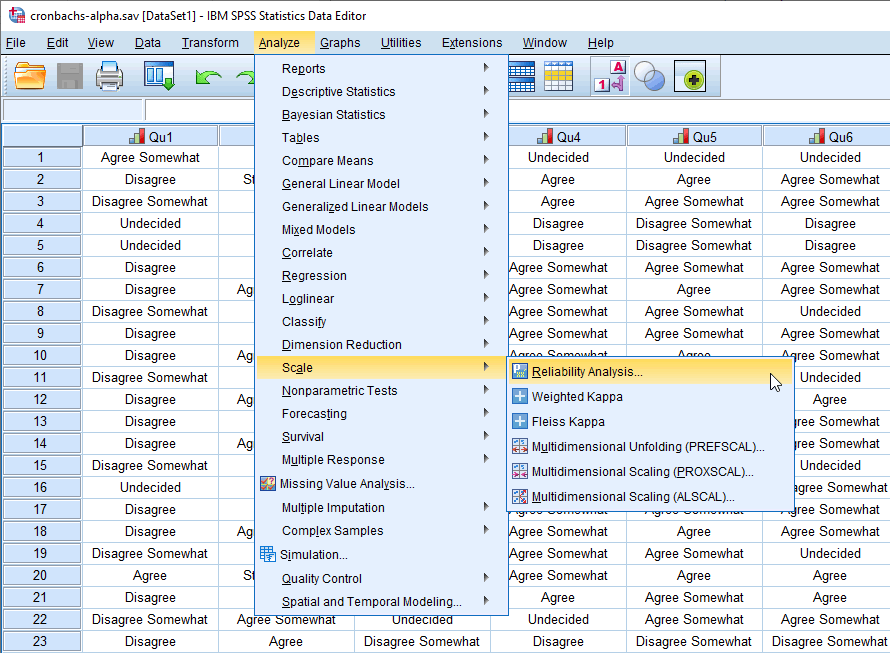
Published with written permission from SPSS Statistics, IBM Corporation.
Yous will be presented with the following Reliability Analysis dialogue box:
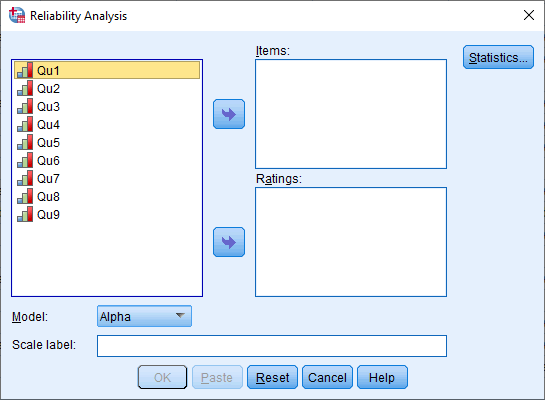
Published with written permission from SPSS Statistics, IBM Corporation.
- Transfer the variables Qu1 to Qu9 into the Items: box. You can do this by drag-and-dropping the variables into their corresponding boxes or past using the
 push button. You volition exist presented with the following screen:
push button. You volition exist presented with the following screen: 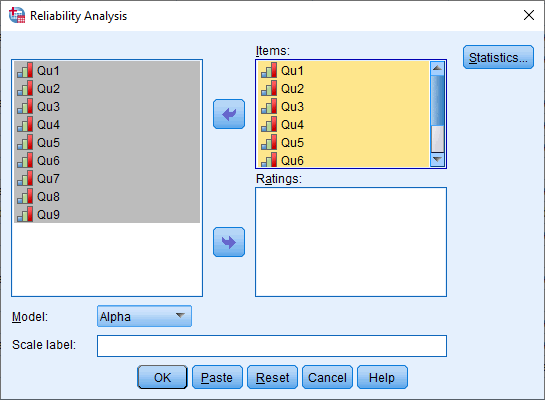
Published with written permission from SPSS Statistics, IBM Corporation.
- Leave the Model: option set as
![Alpha]() , which instructs SPSS Statistics to run Cronbach'due south alpha.
, which instructs SPSS Statistics to run Cronbach'due south alpha. Note: If you want to provide a name for the scale, enter it in the Scale label: box. Since this only prints the name yous enter at the top of the SPSS Statistics output, it is certainly not essential that you do (in our case, nosotros go out it blank).
- Click on the
![Statistics]() button. You volition be presented with the Reliability Assay: Statistics dialogue box, as shown below:
button. You volition be presented with the Reliability Assay: Statistics dialogue box, as shown below: 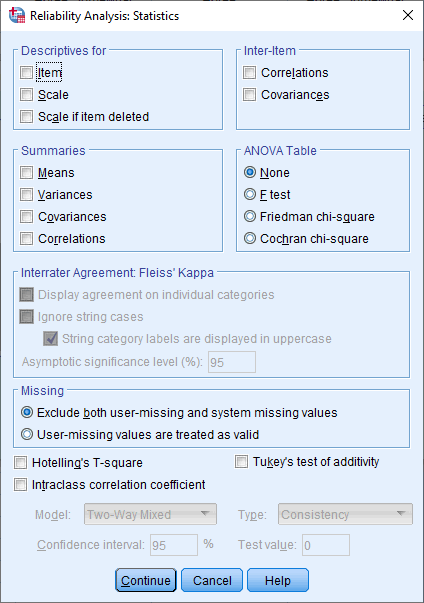
Published with written permission from SPSS Statistics, IBM Corporation.
- Select the Item, Southwardcale and Scale if item deleted options in the –Descriptives for– area, and the Corre50ations selection in the –Inter-Item– area, as shown below:
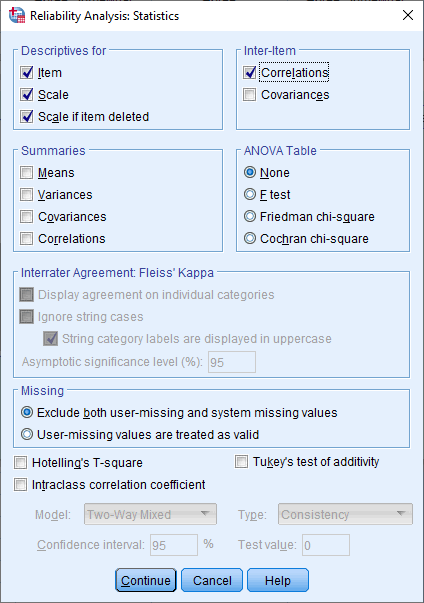
Published with written permission from SPSS Statistics, IBM Corporation.
- Click on the
![Continue]() button. This will return you to the Reliability Analysis dialogue box.
button. This will return you to the Reliability Analysis dialogue box. - Click on the
![OK]() push to generate the output.
push to generate the output.
Now that you have run the Cronbach's alpha procedure, we testify you how to translate your results in the Interpreting Results section. You tin can skip the department beneath, which shows yous how to comport out Cronbach'due south alpha when yous accept SPSS Statistics version 25 or an earlier versions of SPSS Statistics.
SPSS Statistics version 25
and earlier versions of SPSS Statistics
- Click Analyze > Scale > Reliability Analysis... on the meridian carte, as shown beneath:

Published with written permission from SPSS Statistics, IBM Corporation.
You will be presented with the following Reliability Analysis dialogue box:
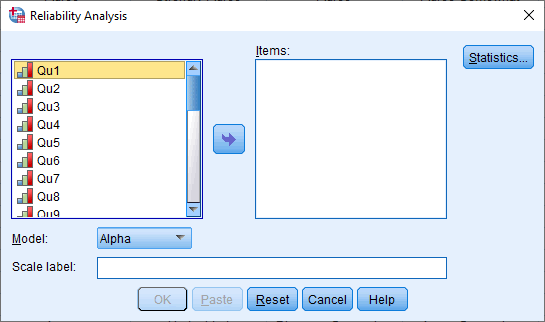
Published with written permission from SPSS Statistics, IBM Corporation.
- Transfer the variables Qu1 to Qu9 into the Items: box. You tin do this past drag-and-dropping the variables into their corresponding boxes or by using the
 button. Y'all will be presented with the following screen:
button. Y'all will be presented with the following screen: 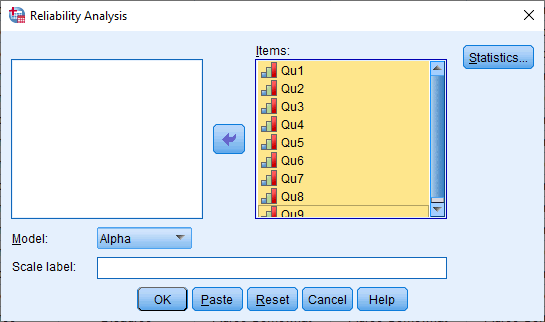
Published with written permission from SPSS Statistics, IBM Corporation.
- Leave the Model: option set as
![Alpha]() , which instructs SPSS Statistics to run Cronbach'southward alpha.
, which instructs SPSS Statistics to run Cronbach'southward alpha. Annotation: If you want to provide a proper noun for the calibration, enter it in the Scale characterization: box. Since this only prints the proper name yous enter at the acme of the SPSS Statistics output, it is certainly non essential that you do (in our example, we leave it blank).
- Click on the
![Statistics]() button. You will be presented with the Reliability Analysis: Statistics dialogue box, as shown below:
button. You will be presented with the Reliability Analysis: Statistics dialogue box, as shown below: 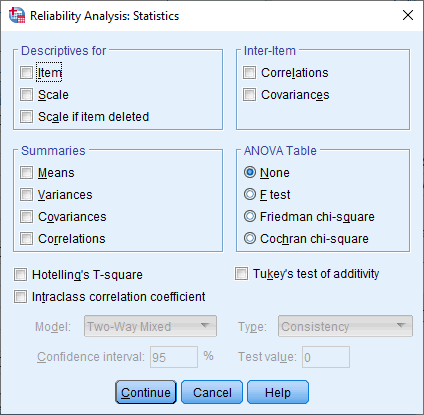
Published with written permission from SPSS Statistics, IBM Corporation.
- Select the Item, Scale and Scale if item deleted options in the –Descriptives for– area, and the Correlations selection in the –Inter-Item– area, every bit shown below:
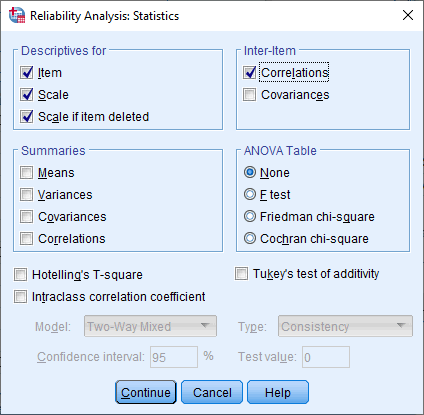
Published with written permission from SPSS Statistics, IBM Corporation.
- Click on the
![Continue]() button. This will return y'all to the Reliability Analysis dialogue box.
button. This will return y'all to the Reliability Analysis dialogue box. - Click on the
![OK]() push to generate the output.
push to generate the output.
Now that you have run the Cronbach'southward alpha procedure, we show you how to translate your results in the next section.

SPSS Statistics
SPSS Statistics Output for Cronbach's Blastoff
SPSS Statistics produces many unlike tables. The first important table is the Reliability Statistics table that provides the actual value for Cronbach's blastoff, as shown below:

Published with written permission from SPSS Statistics, IBM Corporation.
From our example, nosotros can come across that Cronbach's blastoff is 0.805, which indicates a high level of internal consistency for our scale with this specific sample.
SPSS Statistics
Item-Total Statistics
The Item-Total Statistics table presents the "Cronbach'due south Alpha if Detail Deleted" in the final column, as shown below:

Published with written permission from SPSS Statistics, IBM Corporation.
This column presents the value that Cronbach's alpha would be if that detail item was deleted from the scale. We can see that removal of any question, except question 8, would result in a lower Cronbach's alpha. Therefore, we would not want to remove these questions. Removal of question 8 would lead to a small-scale improvement in Cronbach's alpha, and we can also see that the "Corrected Item-Total Correlation" value was low (0.128) for this item. This might lead the states to consider whether nosotros should remove this item.
Cronbach's alpha simply provides you lot with an overall reliability coefficient for a set of variables (e.g., questions). If your questions reverberate different underlying personal qualities (or other dimensions), for instance, employee motivation and employee commitment, Cronbach'due south alpha will not exist able to distinguish betwixt these. In order to practice this and then check their reliability (using Cronbach's alpha), y'all will first need to run a test such as a principal components analysis (PCA). You lot can larn how to acquit out principal components analysis (PCA) using SPSS Statistics, besides as interpret and write up your results, in our enhanced content. You can acquire more on our Features: Overview page. It is also possible to run Cronbach's alpha in Minitab.
Source: https://statistics.laerd.com/spss-tutorials/cronbachs-alpha-using-spss-statistics.php
Posted by: stubbslieuphe.blogspot.com











0 Response to "How To Change Alpha Level In Spss"
Post a Comment